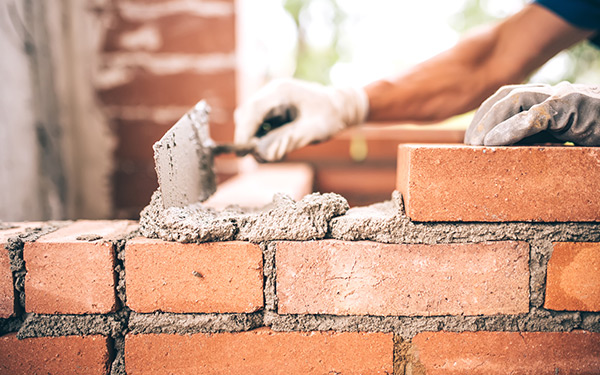Opening the Tricks of Sustainable Stonework Building Practices for Eco-Friendly Structures
In the realm of modern building, the pursuit of lasting methods has actually ended up being paramount. Amongst the myriad methods to eco-friendly structure, sustainable stonework construction attracts attention as a tried and true and durable technique that holds a wealth of untapped possibility. From the choice of products to innovative building and construction techniques, the secrets to accomplishing sustainability within masonry building are multifaceted and fascinating. By checking out the advantages, materials, techniques, and future fads of sustainable masonry, a deeper understanding of just how these methods can form the future of environment-friendly buildings arises.
Benefits of Sustainable Masonry Construction
Embracing lasting stonework building and construction techniques not just lowers ecological effect however likewise provides long-term economic advantages to contractors and areas. By making use of products like recycled blocks, obstructs, and rocks, builders can considerably decrease the carbon impact of their tasks while advertising source effectiveness. Furthermore, sustainable masonry building techniques, such as proper insulation and thermal mass homes, can enhance energy performance within structures, resulting in minimized functional costs over time.
Furthermore, the toughness and durability of stonework structures contribute to long-lasting financial advantages. Structures built making use of lasting masonry methods commonly call for less repair and maintenance, converting to cost savings for building contractors and homeowner. The long life of stonework materials likewise makes certain that structures stay secure and protected, lowering the demand for regular improvements or substitutes.
Eco-Friendly Masonry Materials
Using environment-friendly stonework products is a crucial action in the direction of improving the sustainability of building and construction practices and minimizing ecological impact while maximizing lasting financial advantages. Lasting masonry products are sourced, generated, and made use of in a fashion that lowers general ecological influence. Products such as recycled blocks, recovered rock, and lasting concrete blocks are coming to be progressively preferred options for eco-conscious contractors. Recycled bricks, as an example, not only draw away waste from land fills yet additionally require much less power to generate compared to brand-new bricks. Redeemed stone provides a special aesthetic allure while minimizing the demand for brand-new quarrying. Lasting concrete obstructs incorporate recycled aggregates and might feature enhanced insulation buildings, adding to power effectiveness in structures.
In addition, natural products like adobe, rammed planet, and straw bales give exceptional thermal mass homes, minimizing the requirement for home heating and cooling down energy. These materials are often in your area available, promoting regional economic situations and decreasing transportation-related carbon emissions. By picking green masonry products, construction projects can dramatically reduce their ecological footprint and contribute to the creation of much healthier, more lasting built atmospheres.
Energy-Efficient Stonework Methods
Power efficiency plays a crucial role in improving the sustainability of stonework building and construction methods. By floor slab design implementing energy-efficient masonry techniques, home builders can substantially lower the general power consumption of a building, bring about reduced operational prices and sika concrete repair a smaller sized ecological impact. One key energy-efficient stonework method is using thermal mass, which involves incorporating thick materials like concrete or brick into the structure's framework to soak up and save warmth. This aids manage interior temperatures, decreasing the need for mechanical heating and cooling down systems.

Advancements in Lasting Stonework
Current innovations in lasting masonry techniques have actually produced cutting-edge methods that are reshaping the building and construction sector. One such development is the growth of self-healing concrete, which utilizes bacteria embedded within the concrete to heal cracks autonomously. This advancement not only lowers maintenance costs however additionally enhances the longevity of masonry structures, adding to their sustainability.
One more remarkable innovation is the use of recycled accumulations in stonework building and construction - masonry contractor. By incorporating materials such as smashed ceramic waste or recycled glass right into concrete blends, contractors can minimize the ecological impact of building jobs while keeping architectural integrity. This practice not only diverts waste from garbage dumps however likewise preserves natural deposits, making it a vital innovation in lasting stonework building and construction
In addition, the assimilation of electronic layout devices, such as Structure Details Modeling (BIM), is changing the means stonework frameworks are prepared and built. BIM enables for more accurate calculations, decreased material waste, and enhanced energy effectiveness, eventually causing even more sustainable building practices. These advancements jointly indicate an encouraging future for lasting stonework building in the age of eco-friendly buildings.
Future Trends in Stonework Sustainability
With the cutting-edge navigate to these guys strides made in lasting masonry practices, the future trends in masonry sustainability are poised to further reinvent the building and construction industry. One of the crucial fads forming the future of stonework sustainability is the raised assimilation of modern technology. Advancements such as Building Information Modeling (BIM) and online truth simulations are being used to maximize stonework building and construction procedures, leading to reduced product waste and boosted power performance in structures.
Additionally, the development of novel lasting products is readied to play a substantial role in boosting the eco-friendliness of masonry construction. masonry contractor. Innovations like self-healing concrete, recycled accumulations, and bio-based binders are acquiring traction for their ability to reduce environmental impact while maintaining architectural integrity

Verdict
In conclusion, sustainable stonework construction practices provide many benefits for environment-friendly structures. By making use of eco-friendly materials and energy-efficient techniques, masonry can add to a much more lasting constructed environment. Technologies in sustainable masonry are constantly being created to further improve the ecological efficiency of structures. Looking in the direction of the future, the fad of stonework sustainability is expected to grow, resulting in even more eco-friendly and energy-efficient construction practices in the years to come.